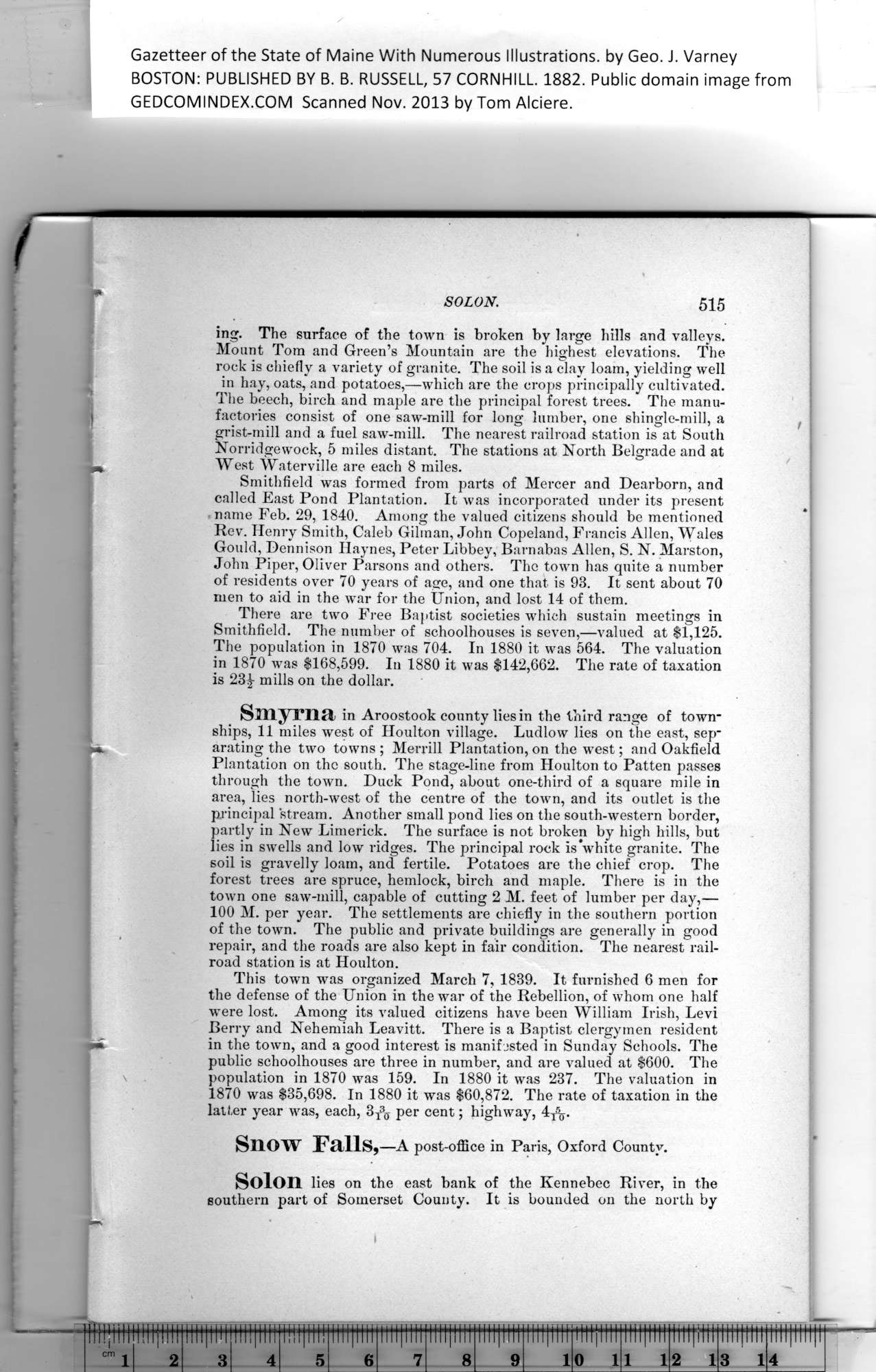|
r
Gazetteer of the State of Maine With Numerous Illustrations, by Geo. J. Varney
BOSTON: PUBLISHED BY B. B. RUSSELL, 57 CORNHILL. 1882. Public domain image from
SOLON. 515
ing. The surface of the town is broken by large hills and valleys.
Mount Tom and Green’s Mountain are the highest elevations. The
rock is chiefly a variety of granite. The soil is a clay loam, yielding well
in hay, oats, and potatoes,—which are the crops principally cultivated.
The beech, birch and maple are tbe principal forest trees. The manu-
factories consist of one saw-mill for long lumber, one shingle-mill, a
grist-mill and a fuel saw-mill. The nearest railroad station is at South
Norridgewock, 5 miles distant. The stations at North Belgrade and at
West Waterville are each 8 miles.
Smithfield was formed from parts of Mercer and Dearborn, and
called East Pond Plantation. It was incorporated under its present
name Feb. 29, 1840. Among the valued citizens should be mentioned
Rev. Henry Smith, Caleb Gilman, John Copeland, Francis Allen, Wales
Gould, Dennison Haynes, Peter Libbey, Barnabas Allen, S. N. Marston,
John Piper, Oliver Parsons and others. The town has quite a number
of residents over 70 years of age, and one that is 93. It sent about 70
men to aid in the war for the Union, and lost 14 of them.
There are two Free Baptist societies which sustain meetings in
Smithfield. The number of schoolhouses is seven,—valued at $1,125.
The population in 1870 was 704. In 1880 it was 564. The valuation
in 1870 was $168,599. In 1880 it was $142,662. The rate of taxation
is 23^- mills on the dollar.
Smyrna in Aroostook county lies in the third range of town*
ships, 11 miles west of Houlton village. Ludlow lies on the east, sep*
arating the two towns ; Merrill Plantation, on the west; and Oakfield
Plantation on the south. The stage-line from Houlton to Patten passes
through the town. Duck Pond, about one-third of a square mile in
area, lies north-west of the centre of the town, and its outlet is the
principal stream. Another small pond lies on the south-western border,
partly in New Limerick. The surface is not broken by high hills, but
lies in swells and low ridges. The principal rock is’white granite. The
soil is gravelly loam, and fertile. Potatoes are the chief crop. The
forest trees are spruce, hemlock, birch and maple. There is in the
town one saw-mill, capable of cutting 2 M. feet of lumber per day,—
100 M. per year. The settlements are chiefly in the southern portion
of the town. The public and private buildings are generally in good
repair, and the roads are also kept in fair condition. The nearest rail-
road station is at Houlton.
This town was organized March 7, 1839. It furnished 6 men for
the defense of the Union in the war of the Rebellion, of whom one half
were lost. Among its valued citizens have been William Irish, Levi
Berry and Nehemiah Leavitt. There is a Baptist clergymen resident
in the town, and a good interest is manifested in Sunday Schools. The
public schoolhouses are three in number, and are valued at $600. The
\ population in 1870 was 159. In 1880 it was 237. The valuation in
1870 was $35,698. In 1880 it was $60,872. The rate of taxation in the
latter year was, each, 3T35 per cent; highway, 4^.
Snow Falls,—a post-office in Paris, Oxford County.
Solon lies on the east bank of the Kennebec River, in the
southern part of Somerset County. It is bounded on the north by
PREVIOUS PAGE ... NEXT PAGE
This page was written in HTML using a program written in Python 3.2
|
